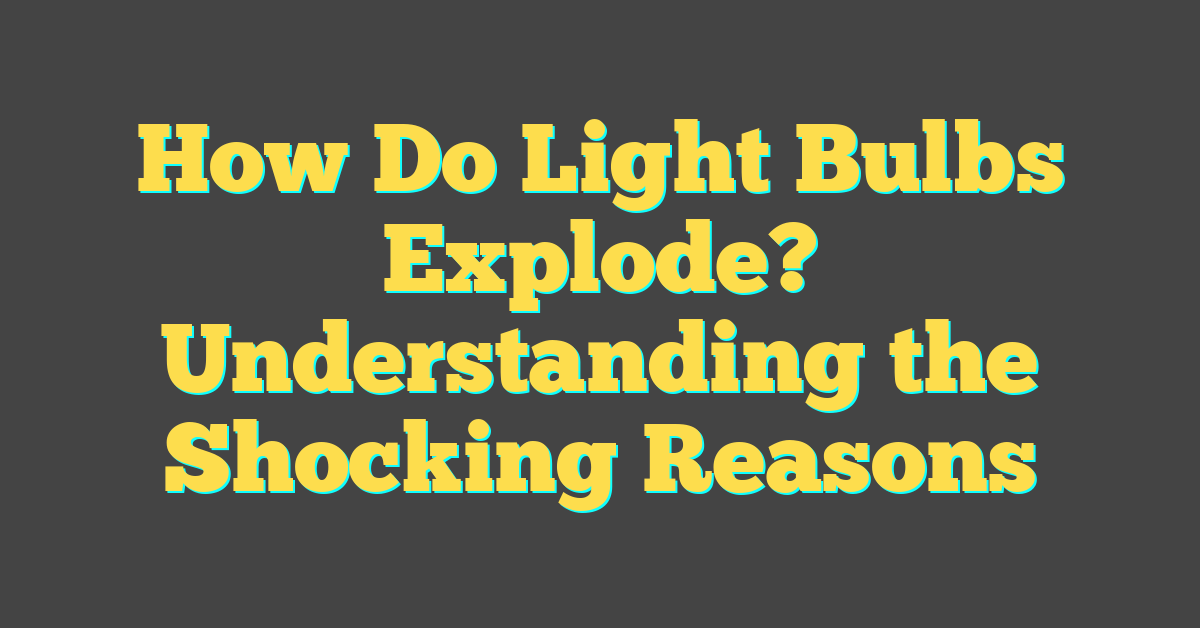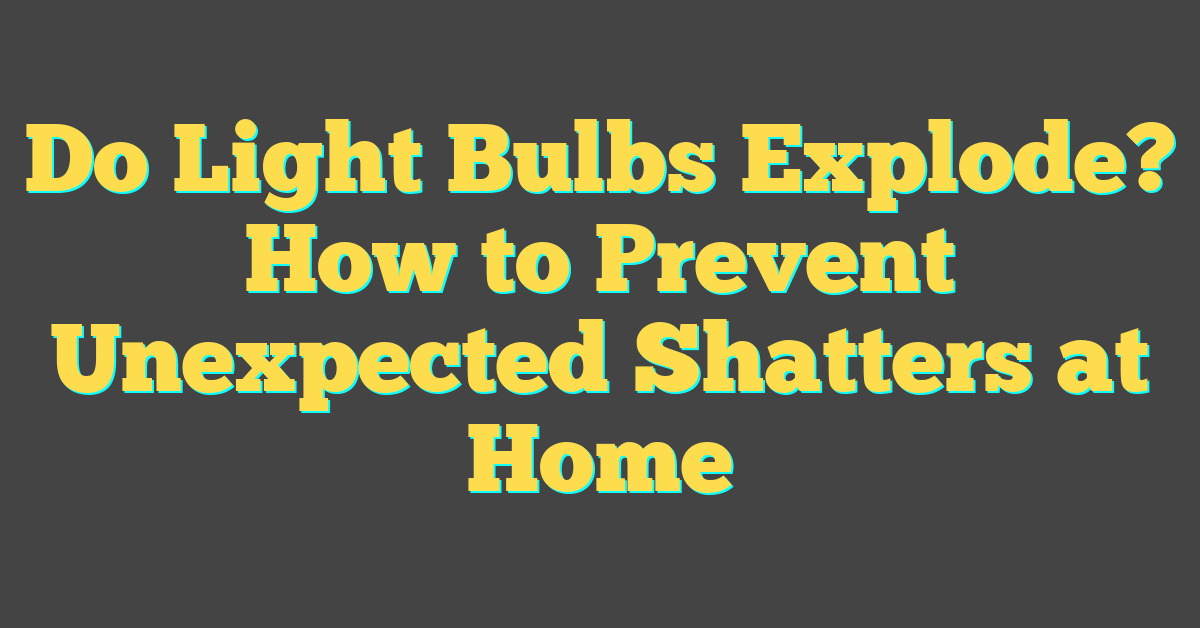Ever walked into a room, flipped the switch, and pop—you’re in the dark, accompanied by the sound of shattering glass? It’s not just your luck; light bulbs can and do explode. But have you ever wondered why?

Exploding light bulbs aren’t just startling—they’re a curious phenomenon that can leave you puzzled and sweeping up glass. Let’s shed some light on the surprising reasons behind these unexpected mini fireworks.
Why do Light Bulbs Explode?
In your experience with lighting and DIY projects, you’ve likely come across a light bulb that’s met an untimely end through explosion. Let’s illuminate the reasons why this happens.
Firstly, thermal stress. Light bulbs generate heat. When they’re turned on, the temperature rises significantly and if there’s any flaw in the glass, like a microscopic crack or impurity, the stress can cause the bulb to shatter. This is particularly likely if the bulb’s hot surface comes into contact with cool water or even a sudden draft of cold air.
Another cause of bulb explosions is faulty wiring or connections. These can lead to power surges that place extra stress on the light bulb’s filament. Imagine your circuit is a busy highway and suddenly there’s an influx of cars at high speed—that’s comparable to what happens in a power surge. The overwhelmed filament can snap and sometimes take the bulb with it.
Here’s a list of additional common culprits:
- Loose bulbs: A bulb that isn’t screwed in securely can jiggle and lead to an electrical arc, which generates intense heat.
- Excessive wattage: Using a bulb that exceeds the fixture’s recommended wattage can result in overheating. Always check the fixture’s max wattage before you install a light bulb.
- Power voltage fluctuations: Your home’s electrical system might deliver inconsistent voltages that can weaken the bulb over time.
- Manufacturer defects: Though quality control is stringent, no process is perfect. A bad batch can escape the factory floor.
To avoid the startling effects of exploding bulbs, stay diligent about using the right bulbs for your fixtures and keeping an eye on the condition of your bulb. Ensure that they’re always firmly installed and replace them if you notice any signs of wear or aging.
Remember, your lighting fixtures are just as important as the bulbs that go into them. A well-matched bulb and fixture not only ensure longer life for both but also reduce the risk of an unexpected light bulb detonation. Keep your home well-lit and safe by sticking to these practices, and your DIY lighting projects will shine bright without any unwelcome surprises.
Common Causes of Light Bulb Explosions

Delving deeper into the intricacies of light bulbs exploding, you’ll find several common culprits that can turn your illuminating friend into a precarious problem. Grasping the reasons behind these eruptions will not only boost your DIY prowess but also help you foster a safer, glow-filled home.
Thermal Stress: Think of your bulb as a mini ecosystem. Changes in temperature can cause materials to expand and contract. If a bulb is trapped in a fixture that doesn’t dissipate heat well, or if the ambient temperature swings wildly, this can lead to a tension-filled dance between contracting metal and expanding glass, ending in a bang.
Faulty Wiring or Connections: Just like you wouldn’t want to walk in mismatched shoes, bulbs hate poor connections. A loose wire can lead to sparks or surges that challenge the bulb’s integrity. Over time, the repeated stress from these electrical misfires can be enough to cause an explosion.
Excessive Wattage: Ever feel overwhelmed? Bulbs do too, especially when shoved into a relationship with fixtures that demand more than the bulb can handle. Placing a high-wattage bulb in a low-wattage fixture overburdens the bulb’s capabilities, creating excessive heat that can lead to a dramatic exit.
Power Voltage Fluctuations: Your bulbs prefer a stable relationship with their power source. Sudden jolts of high voltage are akin to a stressful day—they can take a toll. Regular spikes in electrical supply can fatigue the bulb’s elements, leading to their untimely demise.
Manufacturer Defects: No one’s perfect—and neither are bulbs. Sometimes, despite all precautions, a bulb comes off the production line with a flaw invisible to the naked eye but catastrophic in function. Although rare, these defects can turn a simple screw-in task into an unexpected light show.
« Is Light Bulbs Gas? Unlock the Secrets to Longer Lasting Illumination
How Do I Know My Light Bulb Size? Easy Measuring Tips and Tricks »
Remember, your bulbs work tirelessly to light up your world. Giving them the right environment and checking their health isn’t just practical—it’s a sign of respect for the silent, steadfast companions that brighten your home. Keep an eye on these factors, and you’re on track to keep the light—and not the shrapnel—flying.
Overheating: A Major Culprit behind Light Bulb Explosions

When you’re tackling your next DIY lighting project, it’s crucial to understand how overheating can lead to light bulb explosions. This isn’t just about selecting the right bulb; it’s about ensuring the longevity and safety of your lighting fixtures.
Heat buildup in and around a light bulb can be fatal for its survival. Every electric bulb produces heat, but the design and material can determine how well it handles those temperatures. Usually, bulbs are made to disperse heat efficiently, yet sometimes, the heat dissipation system fails.
Consider this: if a bulb is encased in an enclosed fixture without proper ventilation, the air inside heats up. This trapped hot air increases the pressure on the glass, which can lead to thermal stress. Eventually, the glass may give way, resulting in an explosion. This scenario underscores the importance of matching the bulb to the fixture.
Here’s another heated fact for your DIY toolkit: using a bulb with wattage higher than recommended for your lamp can overdrive the system. It’s like pushing a car to its limits in a hot desert—eventually, the engine will wear down. Similarly, a bulb that’s too hot essentially “burns” through its life rapidly, leading to a potential blowout. Always check the lamp’s specs to avoid this pitfall.
Moreover, insulating materials like lampshades or decor that block air circulation can also cause bulbs to overheat. It’s not just about aesthetics; you’ve got to make sure your design plans allow for proper airflow.
If you’ve ever touched a bulb after it’s been on for a while, you know they can get incredibly hot.
Here are some tips to ensure heat doesn’t lead to trouble in your lighting endeavors:
- Use the Appropriate Wattage: Never exceed the recommended wattage for light fixtures.
- Proper Installation: Ensure bulbs are screwed in securely but not too tight.
- Adequate Ventilation: Choose light fixtures that provide enough air circulation to dissipate heat.
- Regular Checks: Monitor the temperature around the bulb during and after use.
Remember, a well-maintained light isn’t just bright; it’s cool to the touch. Keep these pointers in mind and you’ll illuminate your home safely and spectacularly.
Improper Installation: A Risk for Exploding Light Bulbs

When you’re in the thick of a home DIY project, it’s crucial to ensure that every detail, especially those that involve your safety, is covered. Light bulb installation appears straightforward, but did you know that incorrect installation is a key culprit in many bulb explosions?
Handling the Bulb is where things can initially go awry. Always grasp the bulb by its base to avoid putting pressure on the glass. If the glass becomes compromised even the slightest bit during installation, it can greatly increase the risk of explosion.
Screwing the Bulb In Properly: This part can be a bit tricky. You want to make sure it’s secure, but over-tightening can damage the bulb’s structure and contribute to overheating. On the other hand, a bulb that’s too loose will have a poor connection and may flicker, leading to its demise over time.
Matching the Fixture’s Requirements
Every fixture has a recommended bulb wattage and size – and these aren’t mere suggestions. Installing a bulb that exceeds the fixture’s maximum wattage can cause excessive heating since the fixture isn’t designed to handle that amount of energy. It’s not just about the light, it’s about the heat generated as well.
- Use bulbs that match the required wattage.
- Ensure you’re using the correct bulb type.
- Check that the fixture and the bulb have compatible bases.
Ventilation and Environmental Factors
Even if you’ve nailed the installation, remember the operating environment. Bulbs sitting near fabric or flammable materials are accidents in the making. And don’t forget about ventilated fixtures; they’re designed that way for a reason. A lack of proper airflow can trap heat and create a mini oven effect around your bulb – definitely not part of the plan for your cozy, well-lit nook.
- Keep bulbs away from direct contact with materials.
- Ensure fixtures are clear of dust and debris.
- Check that enclosed fixtures are not sealed off, hindering airflow.
By paying attention to how you install your light bulbs and the environment around them, you’re on track to keeping lighting issues at a minimum. After all, lighting up your home is about creating a warm ambiance, not providing a fireworks display.
Defects in Manufacturing: Another Reason for Light Bulb Explosions

Sometimes, even when you’ve done everything right, light bulbs can still go ‘pop’. This can be incredibly frustrating, particularly if you’re a DIY enthusiast who takes pride in maintaining a safe and well-functioning home. Manufacturing defects are often at the heart of these unexpected failures and here’s why.
During production, quality control should catch any flaws, but occasionally, a defective bulb might slip through. These defects can range from tiny cracks in the glass to faulty filaments, disrupting the bulb’s integrity and making them prone to shattering.
Think about the filament – that delicate coil you see when you peer inside a bulb. It’s supposed to be uniform and perfectly installed, but if it’s not—if there’s a weak spot somewhere—that’s a potential ignition point. In other cases, the issue might lie in the base of the bulb where a poor connection can create electrical arcing and lead to dramatic blowouts.
Improper gas inside the bulb is another culprit. Light bulbs often contain inert gases that prevent the filament from oxidizing and breaking. If the wrong gas mix or amount is used during manufacturing, it can significantly shorten the bulb’s lifespan and increase the risk of an explosion.
For your DIY projects, you’ll want to select bulbs from reputable manufacturers. It’s a simple but crucial step that can keep your lighting both functional and safe. Remember, your light fixtures are only as good as the bulbs you choose. So, always opt for quality and credibility—the peace of mind is worth a couple of extra bucks.
Keeping an eye out for recalls can also be insightful. Manufacturers will pull back batches of bulbs when they recognize a persistent flaw, so staying updated on these announcements can prevent you from installing potentially defective bulbs in your home. That said, spot the signs early; dimming, flickering, or unusual sounds might signal internal defects long before a failure occurs. Always replace suspect bulbs promptly to mitigate risks.
Conclusion
So now you’ve got the lowdown on why light bulbs might go out with a bang. Remember, it’s all about treating them right from the start—proper installation and care are key. Stick to the right wattage and give your bulbs room to breathe to keep them from getting too hot under the collar. And while you can’t always spot a defect from the get-go, choosing quality bulbs and staying alert to recalls can help you sidestep the duds. Stay safe and shine on!
Frequently Asked Questions
What causes light bulb explosions?
Light bulb explosions can be caused by improper installation, mismatched wattage, poor ventilation, contact with flammable materials, manufacturing defects such as cracks or faulty filaments, and incorrect gas within the bulb.
How does improper installation increase the risk of light bulb explosions?
Improper installation can lead to loose connections and poor contact with the socket, resulting in overheating and potentially causing the bulb to explode.
Why is matching bulb wattage and size to the fixture important?
Using a bulb with the correct wattage and size for the fixture ensures that the bulb does not overheat, which can reduce the risk of explosions.
Can manufacturing defects cause light bulb explosions?
Yes, defects like cracks in the glass or faulty filaments can compromise the bulb’s integrity, making them more susceptible to shattering and exploding.
How can I prevent installing defective bulbs?
Selecting bulbs from reputable manufacturers and staying informed about product recalls can help prevent the installation of defective bulbs that might explode.




